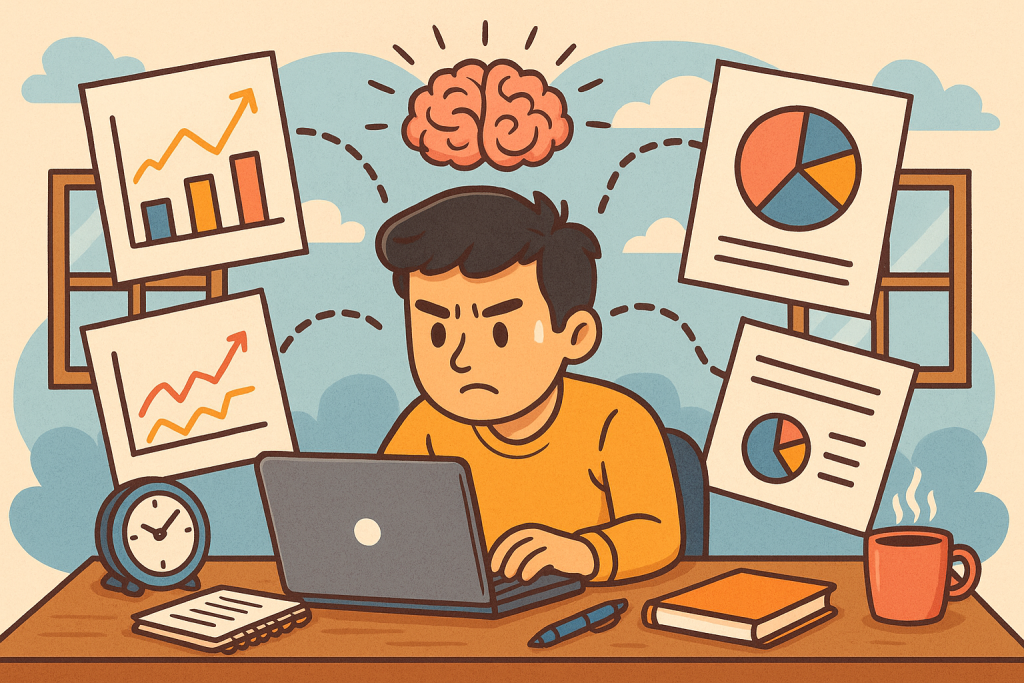Managing multiple projects simultaneously is increasingly common in today’s fast-paced work environments. But how do you maintain focus in a multi-project season without burning out or letting quality slip? Here’s an updated guide packed with research-based techniques and emerging approaches for 2025.

Why It’s Hard to Maintain Focus in a Multi‑Project Season
First, understand the challenge: our brains aren’t wired for juggling many tasks at once. Stanford researchers show that multitasking leads to frequent “task switching” and steep “switching costs,” degrading performance and slowing progress. Indeed, APA confirms that more complex tasks taken on simultaneously make us slower, more error‑prone, and mentally drained .
Moreover, when we face continuous partial attention—a modern phenomenon of scanning multiple streams at once—stress increases and true focus evaporates.
So, if you want to maintain focus in a multi-project season, understanding both neuroscience and attention trends is key.
Emerging Trends in Productivity for 2025
- Attention Management Tools
New AI‑powered platforms now detect optimal focus windows and filter notifications accordingly . - Hybrid Deep‑Work Blocks
Combining remote work flexibility with scheduled “deep‑focus” hours is gaining traction—leveraging both focus and collaboration for high-impact workflows. - Body Doubling via Virtual Platforms
What began as a niche ADHD strategy is now mainstream: peers co‑working virtually to boost accountability and cut distractions.
Practical Guide: 9 Steps to Maintain Focus in a Multi‑Project Season
1. Define Your Focus Keyphrase: “Maintain Focus in a Multi‑Project Season”
Use this phrase in your intro and at least one subheader to reinforce your mindset and SEO.
2. Time‑Block for Deep Focus
Schedule blocks dedicated to one project only—no switching allowed.
Use calendar tools like Google Calendar or Notion. Cal Newport’s concept: work on one task until a stopping point, then reset.
3. Prioritize with the Eisenhower Matrix
Categorize tasks by importance and urgency to avoid drowning in less impactful work.
4. Embrace Single‑Tasking and Pomodoro
Focus on one task in 25‑minute spurts followed by small breaks—a proven combo over multitasking.
5. Use Attention Management Tools
Try apps that suppress notifications and batch alerts during unfocused periods—supported by HCI research in attention systems.
6. Virtual Body Doubling
Pair up with a colleague in a Zoom or co‑working app to boost accountability. This trend helps sustain focus in asynchronous and remote teams .
7. Limit Context Switching
If you switch topics, ensure each block lasts more than three minutes—or ideally 25‑minutes plus break—to avoid cognitive carryover issues .
8. Build Mindfulness Resilience
Daily mindfulness or short meditation sessions help reduce stress and improve attention control—making focus stick in long seasons .
9. Task Micro‑Chunking & 80/20
Break projects into bite-sized portions and apply Pareto’s rule—focus on the 20% that delivers 80% of results .
Sample Weekly Focus Plan
| Day | Morning (Deep Work) | Afternoon (Shallow Work) | Daily Review |
|---|---|---|---|
| Monday | Project A (2×25-min) | Emails / Admin | 10 min reflect & update |
| Tuesday | Project B Block | Follow‑ups & To‑Do Prep | Check alignment |
| Wednesday | Body‑Double Sprint (Project C) | Shallow tasks | Flag tomorrow’s focus |
| … | … | … | … |
Why This Works: The Science
- Switching Costs: Frequent task swaps cause mental drag and inefficiency.
- Deep Work: Sustained attention periods result in better outcomes than scattering effort across tasks.
- Attention Filtering: Smart notification blockers enhance attention capacity.
- Peer Accountability: Shared focus sessions (body doubling) improve motivation and completion rates.
Tips to Stay on Track
- Track Focus Habits: Use simple logs or tools like RescueTime.
- Set a Trend‑Driven Mindset: Remind yourself that this isn’t just a fad—it’s a productivity evolution in 2025.
- Reflect Weekly: Adjust time blocks and methods based on what worked.
Final Thoughts
A multi‑project season doesn’t have to mean chaos. By aligning emerging productivity trends—attention management tech, hybrid time‑blocking, virtual body‑doubling—with science‑backed habits like single‑tasking and micro‑chunking, you can maintain focus in a multi‑project season and produce your best work yet.
References
Allen, D. (2001) Getting Things Done: The Art of Stress-Free Productivity. New York: Penguin Books. Available at: https://www.penguinrandomhouse.com (Accessed: 17 June 2025).
Baumeister, R.F. and Tierney, J. (2011) Willpower: Rediscovering the Greatest Human Strength. New York: Penguin Press. Available at: https://www.penguinrandomhouse.com (Accessed: 17 June 2025).
Mark, G., Gonzalez, V.M. and Harris, J. (2005) ‘No Task Left Behind? Examining the Nature of Fragmented Work’, Proceedings of the SIGCHI Conference on Human Factors in Computing Systems, pp. 321–330. Available at: https://doi.org (Accessed: 17 June 2025).






